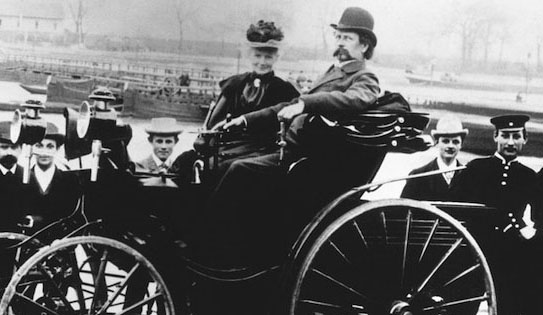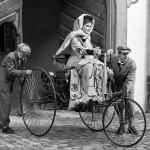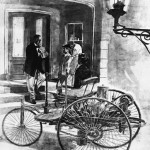
Germany’s Karl Benz is credited with inventing the automobile but it was his wife Bertha who saw its true potential and pioneered what has been called the most important car journey ever undertaken.

It was in August, 1888, two years after Benz patented his invention. Bertha slipped out of bed early, gathered up her two boys, Eugen and Richard, and left a note on the kitchen table for the sleeping Karl, saying she was going to visit her mother for a few days. Karl and Bertha lived in Mannheim; her mother was in Pforzheim, about 90km away. Bertha made no mention of how she and the boys would get there. But the 39-year-old was resourceful. She was also independently wealthy and had bankrolled much of the car’s development
Quietly, mother and sons pushed the Model III Patent Motorwagen far enough away from the house so the noise of it starting up wouldn’t wake Karl. (A modern take on them leaving home is pictured above). She cranked up the 1.6-litre single-cylinder engine and phutted off along what was basically a track for coach and horses linking small villages. There were no signposts as such. It was the start of what has been hailed as the first long-distance journey by car. But it wasn’t without incident.
Karl might have been an engineering whizz but he was no visionary. He didn’t even think to fit the car with a fuel tank. The 4.5-litre capacity carburettor was it. There was no cooling system for the 1.8kW (2.5bhp) engine. When it got hot Karl had poured water over it, letting it evaporate and taking with it the engine’s heat. The oil system was crude, too. It was dripped from a container into one end of the engine and what wasn’t burned off by the motion of the single cylinder fell out of the other end through the open crankcase and on to the ground.

The engine soon began to overheat and Bertha and her boys were scooping up water from streams and rivers and knocking on doors for more. Even a gradual hill would tax the engine and the boys would get out and push. People along the way helped push, too. Fuel was easier to get. Back then a form of petroleum ether called ligroin was sold over the counter at pharmacies. Bertha’s first stop for fuel was at Wiesloch, at a pharmacy that inadvertently became the world’s first petrol station. The shop is still there today.
If progress was slow anyway it came to a halt when the car broke down. First a fuel line became blocked. Bertha, ever resourceful, unblocked it with a hatpin. Then an exposed ignition wire caused problems. This time Bertha insulated it with a garter from her stockings. Eventually, she and the boys arrived at her mother’s, an estimated 15 hours, say historians, after leaving Mannheim. Average speed, they say, was around 6km/h. Next morning she sent a telegram to Karl explaining what she had done.
A few days later she returned to Mannheim by another route. She was better equipped this time and the car largely ran without a hitch, although a cobbler had to cover the brake shoes with leather to stop them wearing out. The upshot of the journey, say historians, is that Bertha proved that a woman was every bit as capable as a man of handling the newfangled machines; that the car was a tool and not a toy; and that her husband Karl had created the single most important invention in the history of transport since the wheel.

Also, her journey proved the value of durability test runs. Benz fitted the car with a lower gear after that so it could climb hills without passengers having to get out and push. Bertha died in 1944, aged 95. In honour of her 1888 journey is the Bertha Benz Memorial Route. Tourists to Mannheim can drive it – these days it’s signposted.
